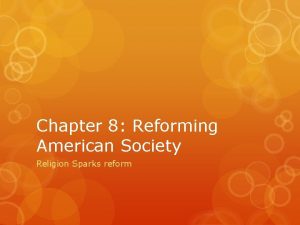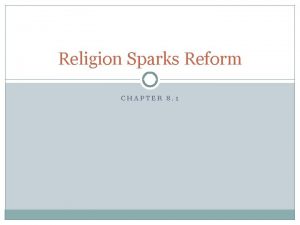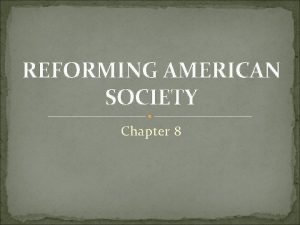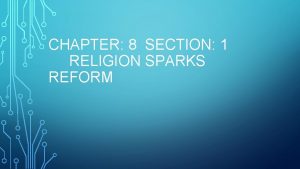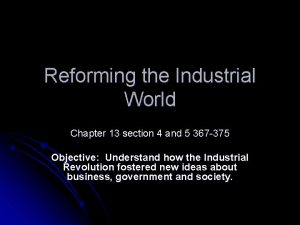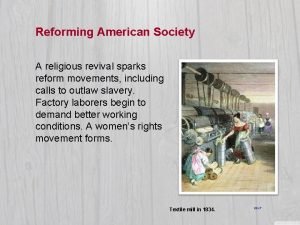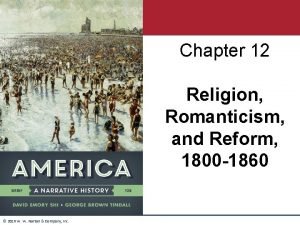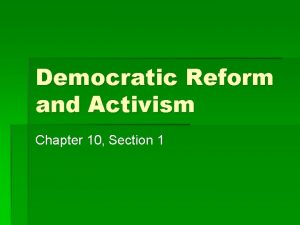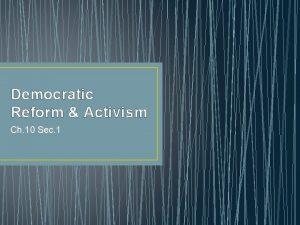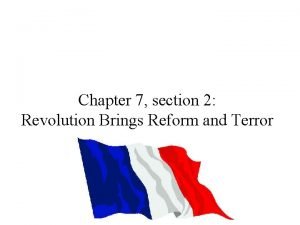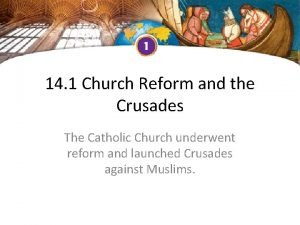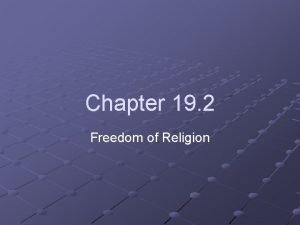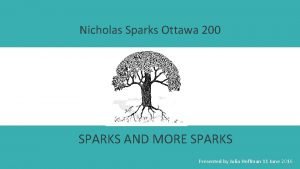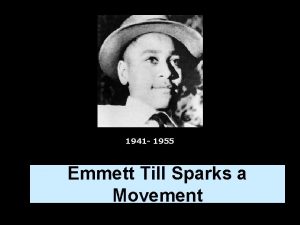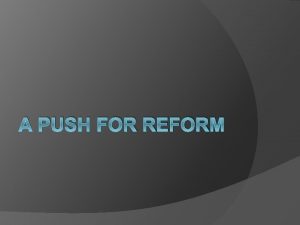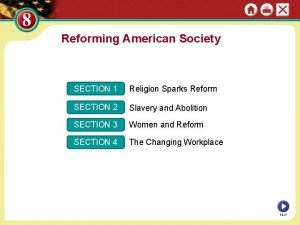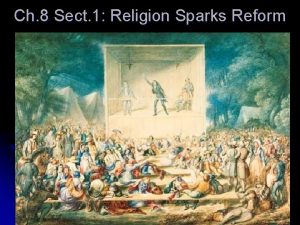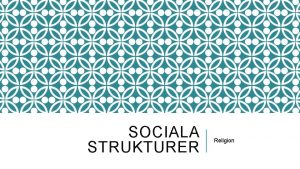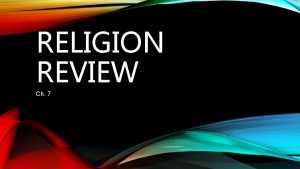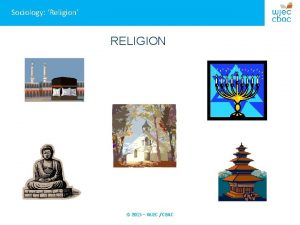Chapter 8 Notes Section 1 Religion Sparks Reform
















- Slides: 16

Chapter 8 Notes

Section 1: Religion Sparks Reform • *Charles Grandison Finney- was a preacher during this era of reform that started in the 1830 s. • -Other reformers of this period included women's rights, social reform, and abolition. • • *________________- was a religious movement that swept the US after 1790. • -Finney and other preachers rejected the 18 th century Calvinistic belief that God predetermined one's salvation or damnation. • -They emphasized individual responsibility for seeking salvation, and insisted that people could improve themselves and society. • -These preachers would often hold *________ that would last for five days. • -This Great Awakening also brought Christianity on a large scale to the enslaved African-Americans.

Transcendentalism and Reforms • *_________________- a New England writer, nurtured taking new pride in the emerging culture. He led a group practicing *_____________- a philosophical and literary movement that emphasize living a simple life and celebrated the truth found in nature and in personal emotion and imagination. • -This spawned a literary movement that stressed American ideas of optimism, freedom, and self-reliance. • *_________________ put the idea of self-reliance into practice by abandoning community life and building a cabin where he would live alone for two years. • -Believing in the importance of individual conscience, he urged people not to obey laws they considered unjust by protesting peacefully. This is known as *______________. • -Thoreau went to jail for not paying his taxes because they helped finance the war. • • -_________, on the other hand, did not appeal to emotions, but emphasized reason and appeals to conscience as the path to perfection. This attracted a wealthy and educated following in New England. They believed that conversation was a gradual process and agreed with revivalists that individual and social reform was possible and important. •

Americans Form Ideal Communities • -Some of the optimism of religious and social reform inspired the establishment of *utopian communities- experimental groups who tried to create a "______, " or perfect place. They varied in their philosophies, but shared common goals such as self-sufficiency. • -One of the best known was established in New Harmony, Indiana. • -Another was _______, near Boston “to prepare society of liberal, intelligent and cultivated persons, whose relations with each other would permit a more wholesome and simple life that can be led amidst the pressure of our competitive institutions. " Brooks Farm suffered a fire to a main building, which led to it being disbanded. • -Most utopias lasted no more than a few years. • Shaker Communities • -Religious beliefs spurred other ideal communities. • -The ______set up their first communities in New York, New England, and on the frontier. • -They shared their goods with each other, believed that men and women were equal, and refuse to fight for any reason. • -When a person became a Shaker, they vowed not to marry or have children. • -They depended on converts and adopting children to keep the community going. • -In 1999, only about seven Shakers remained in the US.

Schools and Prisons Undergo Reforms • -French writer *_______________ was visiting the US to study its penitentiary system when he observed the systems very harsh punishments. He and other reformers quickly took up the cause. • *_______________- found out that many jails housed mentally ill people. In turn, she convinced the Massachusetts Legislature to pass a law aimed at improving these conditions. She went on to persuade nine Southern states to set up hospitals for the mentally ill. • -Prison reformers and Dorothea emphasized the idea of ____________. • • -Before the mid-1800 s, there were no uniform educational policies. • -Massachusetts and Vermont were the only states to pass a compulsory school attendance law. In other states, it was common for kids to drop out before they were 10 years old. • -In the 1830 s many began to demand a tax to support public schools. • *___________ was one of the leading reformers of public schools. • -In 1837 he became the first secretary of the Massachusetts Board of Education setting up programs and curriculum reforms.

Section 2: Slavery and Abolitionists Speak Out • -By the 1820 s, more than 100 anti-slavery societies were advocating for the resettlement of blacks to Africa. -This was based on the belief that they were an inferior race and that they could not coexist with the white society. • -White support for *_________ was fueled by preachers such as *Charles G. Finney, who termed slavery "a great national sin. " • *_____________ was the most radical white abolitionist. • -Active in religious reform, he started his own paper, ___________, in 1831 to deliver an uncompromising message of immediate *___________. • -Garrison was well hated by whites who opposed abolition and alienated whites even more when he associated with abolitionist *____________. • -Walker, a free black, wrote his Appeal to the Colored Citizens of the World in 1829. It advised blacks to fight for freedom, rather than wait for slave owners to end slavery. • -At this time blacks were only able to get the lowest paying jobs in the country.

• *_____________- who was born into slavery had been taught to read and write by the wife of one of his owners. He too lent his voice to the cause of racial equality for over 50 years. • -By 1838, Douglass was earning top wages at his skilled job as a ship caulker, but all his money went to his owner. Douglass would later escape slavery and go to New York. He would go on to work with Garrison until he began his own anti-slavery paper called the _________. • -By 1830, the slave population had grown to 2 million in the US. • -The rise of the plantation system in the mid-18 th-century brought many changes to the lives of the enslaved. • -Men, women, and even children work from dawn till dusk in the fields with the whip of the overseer or the slave driver compelling them to move faster. • -At this time, the promise of cotton wealth had lured many white Southerners into farming, thus creating a shortage of white laborers for such industries as mining and lumber. As a result, a demand arose for slaves as workers in the mills and on ships. • -Rural and urban slavery were very different. Douglass remarked that the differences were, "a city slave is almost a freeman compared with a slave on the plantation. "

• Nat Turner's Rebellion • *__________ was a gifted preacher and slave who believed that he had been chosen to lead his people out of bondage. • -Turner and nearly 80 followers attacked four plantations and killed almost 60 white inhabitants before being captured by state and federal troops. As a result, Turner would be hung. • -In retaliation, whites killed as many as 200 blacks, many which had nothing to do with the uprising. • -Turner's bloody rebellion strengthened the resolve of Southern whites to defend slavery and to control their slaves.

• Virginia Debate- because of Turner's rebellion, the governor of Virginia and many state legislators thought that slavery needed to come to an end soon. When put to a vote in the Legislature, abolition lost, keeping Virginia a slave state. • -That loss and close the debate on slavery in the *_______ (pre-Civil War) South. • -Many slave owners believe that education and privilege inspired revolt. Thus, many slave owners’ pushed to further tighten controls on African-Americans. • -These controls became known as _________. • -In some states, free blacks lost the right to own guns, purchase alcohol, assemble in public, testify in court, vote, own property, learn to read and write, or work independently as carpenters or blacksmiths. • -However, some abolitionists continued to campaign for emancipation by swamping Congress with petitions to end slavery in the District of Columbia. This led to the adoption of a *_________- a rule limiting or preventing debate on an issue -- which deprive citizens of their right to be heard. This turmoil over slavery would lead to a divided nation.

Section 3: Women and Reform • *______________ and Quaker abolitionist *__________vowed to form a society to advocate the rights of women. • -They headed the first women's rights convention in Seneca Falls, New York in 1848, called the *____________________. • -Nearly 300 men and women met to discuss women's rights. • -One resolution that almost did not pass was the calling for women "to secure to themselves their sacred right to the elective franchise, " the right to vote.

Women Mobilize for Reform • -Inspired by the optimistic message of The Second Great Awakening, many women actively participated in all the important reform movements of the 19 th-century. • *______________ daughters of the South Carolina slaveholder, spoke eloquently for _______. Angelina published An Appeal to Christian Women of the South, where she called upon women to overthrow the system of oppression and cruelty. • *_____________________- the effort to prohibit the drinking of alcohol, was another offshoot of the influence of churches and the women's rights movement. • • -Until the 1820 s, American girls had few educational avenues open to them beyond elementary school. • -In 1821, _____________ opened one of the nations first at academically rigorous schools for girls in Troy, New York. The Troy Female Seminary became the model for a new type of women's school.

• -In 1837, Ohio's Oberlin College admitted four women becoming the nations first fully coeducational college. • -In the mid-19 th century, educated women also began to work for health reforms. • -________________l became the first woman to graduate from medical College in 1849 and would later open the New York Infirmary for Women and Children. • -In a survey of women's health, it was found that for every healthy woman, there were three sick women. It was no wonder because women rarely bathed or exercised, and the fashion of the day included corsets so restrictive that breathing sometimes was difficult. • -Amelia Bloomer, publisher of a temperance newspaper, rebelled. She often wore a costume of loose fitting pants tied at the ankles and covered by a short skirt. • -As conditions for slaves worsened, Isabella Baumfree, a slave for the first 30 years of her life, took the name *___________ when she decided to sojourn (travel) throughout the country preaching, and later arguing for abolition. (Read p. 258 - A Personal Voice).

Section 4: The Changing Workplace • Rural Manufacturing- until the 1820 s only the first step in the manufacturing of clothing (the spinning of the cotton into thread) had been mechanized widely in America. • -People then finished the work in a *cottage industry system in which manufacturers provided the materials for goods to be produced at home. • -Then, the finished articles were brought to the manufacturer, who paid them by the piece and gave them new material for the next batch of work. • -As weaving factories and mills opened, they replace this system. • -Skilled artisans had typically provided items that a family could not make for itself. (i. e. furniture and tools) As in cottage industries, the artisans usually worked in shops attached to their own homes. • -Most experienced artisans had titles: a *master might be assisted by a *journeyman- a skilled worker employed by a master, and by an *apprentice, a young worker learning the craft.

Farm Worker To Factory Worker • -In mill towns throughout New England. "Mill girls" lived under strict curfews. The girl's behavior and church attendance was closely monitored. • -________________ hired the most because they could pay them lower wages than men. To the girls in the mills, though, textile work offered better pay then their alternatives: teaching, sewing, and domestic work. • -Conditions at Lowell: work lasted from 5 a. m. to 7 p. m. Heat, darkness, and poor ventilation was common. -Windows would be nailed shut to prevent the threads from breaking. As conditions worsened, workers began to organize. • -In 1834, the Lowell Mills announced a 15% wage cut. 800 Mill girls conducted a *strike under the heading "union is power. " • -They proclaimed that they would not return to work, unless their wages were continued as they had been before. • -As mill owners fired the strike leaders and the Lowell press and clergy criticize the girls, they began to head back to work with the lower salaries. • -In 1836, another strike occurred over an increase in their board charges that was the equivalent to a 12. 5% pay cut. • -Twice as many girls participated in a strike as had two years earlier, but again, the company prevailed.

Workers Seek Better Conditions • -Conditions for all workers deteriorated during the 1830 s. • -The first general strike in the US occurred in 1835. • -European immigration rose dramatically in the US between 1830 in 1860. The majority was from Germany and Ireland. • -Most immigrants went north to the industries. After The Great Potato Famine in Ireland in 1845, more than one million Irish immigrants fled to the US willing to take low-wage jobs that harmed anyone else's chance of getting them. This in turn made Americans very angry.

National Trades’ Union • -One of the earliest strikes was in 1806 by journeymen shoemakers. • -During the 1830 s, trade unions in different towns began to join together to establish individual unions. The workers sought to standardize wages and conditions throughout each industry. • -In a few cities, trade unions united to form federations. • -In 1834, journeymen's organizations from six industries formed the largest of these unions, the *National Trades Union, which lasted for three years. • -They faced fierce opposition from bankers and owners, who threaten the unions by forming associations of their own. • -Workers efforts to organize were also hampered by court decisions declaring strikes illegal. • • -In 1842, the Massachusetts Supreme Court supported workers’ rights to strike in the case of ___________________. In this case the court upheld the rights of laborers. • -As the nation adjusted to the newly emerging market economy, migration west became a popular option.
 Chapter 8 section 1 religion sparks reform answer key
Chapter 8 section 1 religion sparks reform answer key Chapter 8 section 1 religion sparks reform
Chapter 8 section 1 religion sparks reform Chapter 8 section 1 religion sparks reform
Chapter 8 section 1 religion sparks reform Religion sparks reform
Religion sparks reform Chapter 9 section 4 reforming the industrial world
Chapter 9 section 4 reforming the industrial world Religion sparks reform
Religion sparks reform Chapter 12: religion, romanticism, and reform, 1800–1860
Chapter 12: religion, romanticism, and reform, 1800–1860 Chapter 10 section 1 democratic reform and activism
Chapter 10 section 1 democratic reform and activism Chapter 10 section 1 democratic reform and activism
Chapter 10 section 1 democratic reform and activism Chapter 7 section 2 revolution brings reform and terror
Chapter 7 section 2 revolution brings reform and terror Chapter 23 section 2 revolution brings reform and terror
Chapter 23 section 2 revolution brings reform and terror Chapter 14 section 1 church reform and the crusades
Chapter 14 section 1 church reform and the crusades Western religion vs eastern religion
Western religion vs eastern religion Chapter 19 section 2 freedom of religion
Chapter 19 section 2 freedom of religion Sparks family tree
Sparks family tree Emmett sparks
Emmett sparks Northern nevada adult mental health
Northern nevada adult mental health
